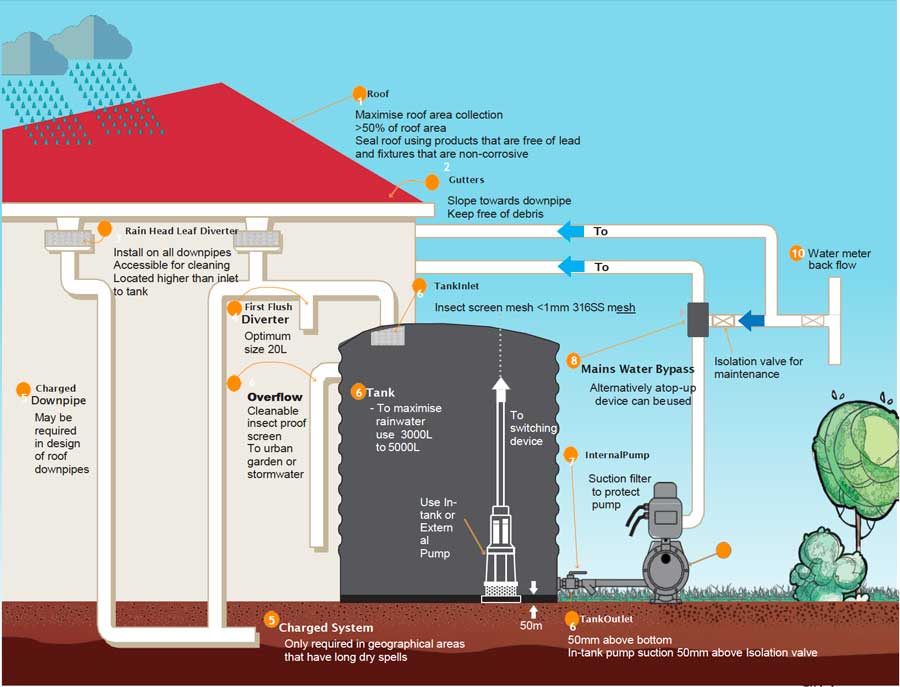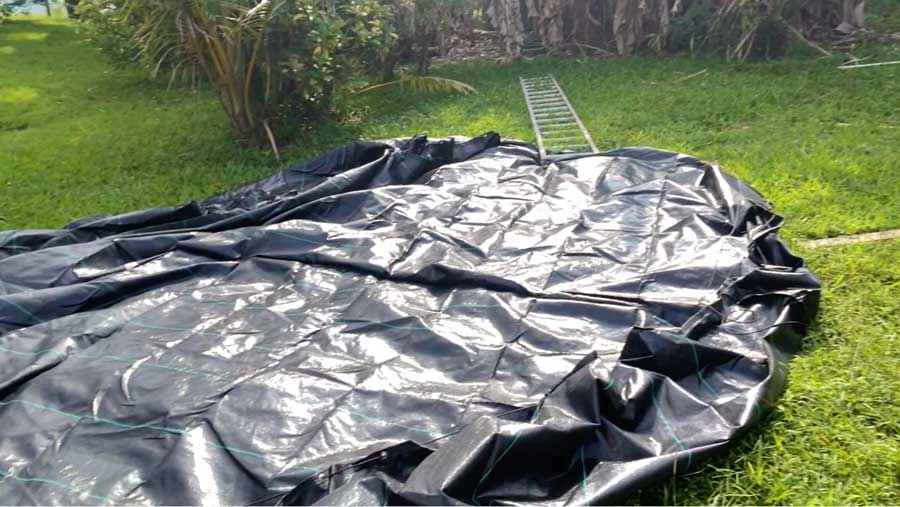
I am going to show you what it takes to replace a very large liner for my 30,000 gallon holding tank for our water supply to the farm.
If you want to be really sustainable it’s a lot of work to keep everything maintained, working correctly and be able to repair anything if needed. Either you know how to fix things or you must have reliable people set you up with the correct equipment, installation and maintenance of your own water supply that feeds your house primary water.
This 3 man crew will show you how we are going to replace the old ripped liner with a new 600+ pound food grade liner in our 30,000 gallon steel water tank. I had to hire the pros at Water Works in Hilo – they specialize in making custom water tank liners and install the tanks and pumps for catchment systems.
Once a new catchment system is installed you will have to keep all of the systems maintained including, but not limited to, replacing water filters and changing the UV light every few years.
There is always at least minimal maintenance that must be done on anything you own, if not things (motorized machines and bodies) start to degrade and fall apart quickly.
If the system is installed correctly then the water systems usually do not need too much maintenance, or repair.
In time everything degrades, and it’s time for us to do some needed repairs and maintenance to the primary water tank for the farm, as you will see.
I will give you an idea on how my system works if you want to catch the rain and use it as your main water source.
I have been catching the rain water from the roof for our main supply for over 12 years. It’s not as easy as you think, but it’s not hard to learn how to keep everything functioning correctly.
Each system is different and can be slightly complicated as to how the entire system runs if you are not familiar with it. It took me a few years to really be able to learn and understand the piping, valves, priming pumps if needed, setting up the pressure tanks with the correct pressures etc. You will have to learn how the system works from top to bottom, but its really worth it to have your own water supply.
If you are going to catch water from the roof and use it as a primary source of water, you will have to have the correct water catchment tank, liner, pump system, pressure tanks, multi-filtration and sanitization process to use and pump the rainwater for household use.
You also should live in an area that yields enough rain to process, to be able to easily sustain yourself. In many rural areas of Hawaii and many other parts of the world, this is how you would get your main water supply by catching the rain from a large roof, and then having the correct setup to correctly process rain water.
Would it be nice if we could all be somewhat sustainable? And be able to have your own private power and water other than the municipal or county supplied? It took me about 5 years and a lot of work to get all of the 3 farms sustainable with their own clean water and ample power generation for the entire farm.
Homesteads are usually built a little at a time and hundreds, or even thousands of upgrades and logistics are needed in any successful venture so that in time it can be much more sustainable, which is the goal.
If you already live on or own a farm type or homestead property, you know what I mean. It takes a lot of hard, but smart work and enthusiasm to learn and practice new ways of a sustainable life and a challenge and personal responsibility to keep everything working, maintained, repaired and from falling apart.
In this day and age, creating your property to be more sustainable is well worth it. Having your own personal water and power supply will make you feel much better by not being a burden on the system that supplies these services to all of the homes that do have the ability to live off the sun, wind for power and the rain for water.
Once you get it all together, it’s a beautiful feeling to have your own personal water and power systems for emergencies and general living.
Once the systems are put into service, I do not have to rely on expensive and (usually at this time) unreliable outside sources. Personally I have not paid for electricity or water in many years with the systems I am using.
The electric company charges me a $25.- dollar fee to keep the county electric meter active. Hawaii is one of the most expensive 47 cents/kilowatt/hour cost, which is more than any other state in the US.
Owning Your Own Water Company
I live on the Big island of Hawaii on the Hamakua coastline. In this area a high percentage of people have rainwater catchment systems. This simply means they capture the rain from the roofs of the house which is then routed via the rain gutters to a large holding tank or cistern, where the water is held in a large tank ready for processing.
Once the water is in the holding tank, pipes are routed from the tank to the house via gravity flow into the pressure pumps. From the pressure pumps the water is forced into the pressure tanks that hold the water under pressure at 38-60 psi.
After pressurizing and filling the pressure tanks, the water now heads to the series of several 20 inch x 4.5 inch filters using a mesh size of 10-20 microns to filter and clean anything in the water to the size of the filter.
Once the water has been pushed through several filters to remove any particulates, the water’s last stage is to go through the strong UV light for effective sanitizing of microbes and parasites. Now the water is ready for use (see pictures below in the description).
Keep in mind, owning your own water and/or power company means you are totally responsible for keeping everything working, maintained and repaired.
Either way, there are pros and cons to having your own systems versus having the power and water supplied to you. If everything is working out well – owning your own systems are much more reliable in the unreliable times we are living in.
Rain Catchment Systems and Municipal Water Plants Differences
As you already well aware, the water from the state/county is water, but the water has been shown to have many types of contaminants from pharmaceuticals, lead and heavy metals, additives such as fluoride, chlorine, aluminum added to give the water more clarity and/or chloramines to keep the water sanitized for commercial uses in the city, homes and farms.
A lot of these types of corrosive chemicals that are added to public water supplies can erode the metal piping over the years, which also adds more heavy metal contaminants to the public water.
If you have ever taken rainwater showers you most likely will have noticed it was the best shower you have ever had – clean distilled water from the sky, without all of the chemicals that are added and/or found in all conventional/municipal water supplies. Most all homes that are living in the populated and commercialized cities and suburbs of the USA and many other countries follow similar practices and distribution.
Rain Catchment Setup
When I go and visit my family in California, I immediately notice that when I use the water, or take a shower, the smell of the chemicalized public water supply. After a few weeks of showering in fluoride and chloramines, I notice my skin is completely dry, and I feel like I have been mildly poisoned with every shower, with a slight light headed feeling.
I am not used to any chemicals in my shower using the rainwater catchment system in Hawaii, so I really notice an immediate difference when using the shower in California.
If you are really looking to be sustainable, the weather has a large factor on whether or not you are even going to be able to be partially sustainable from Nature.
If you live in the desert then most likely you will not have enough rain all year round to catch from the roof, and use as your primary source of water, so you might have to have a well or river.
If you want to use solar power energy then you would want to live in a place that has plenty of sunshine most of the year, etc. In each area you live in you will have to figure out what is best for you to be more sustainable for water and power sources.
Steel Tanks will always need a “food grade” liner and a “meshed” or “solid roof”. Steel tanks are the cheapest way for most people to use as a water catchment tank.
You will always need a food grade liner in the steel tanks, and you should always at least have a meshed nylon roof to protect from direct sunlight, so the algae will not grow as fast.
The meshed roof cover also helps keep debris from falling into the tank. The best way I’ve found is to completely cover the roof with a solid plastic roof to fully shield the water from the sun, and to prevent any algae from growing. If the algae grows in the tank then your filters will clog very quickly and you will have to change them, or clean them more often.
The bottom line is when your filters are starting to get plugged you will notice much less volume and pressure coming out of the faucet, shower or hose. So, the cleaner the filters are the more volume of water you can flow through the filter.
Poly tanks are the way to go if you have the money and can get them in your area. These tanks work excellent to keep the birds, snails, mice and other critters from getting into the tank.
Personally, I would still put a solid roof over the tanks to keep the tanks from being in the direct sunlight. Even if you covered the roof area with a mesh or solid tarp that would help keep the tanks out of the sun.
The direct sunlight exposure would start probably degrading the plastic tank and thus probable leaching of the plastic tank into the water thus contaminating the water supply with known dangerous endocrine disruptors from the petrochemical plasticizers that make the plastic in the tank more flexible and pliable.
Typically a 3 Stage Filter System and UV light setup looks like this. The flow of the water (picture above) cartridge filters goes from right to left.
The 1st Stage Filter is the primary sediment filter. I like to use a 35-50 micron size filter to capture all particulates in the water in the 1st stage.
The 2nd Stage Filter is the charcoal filter which cleanses the water from many contaminants that could be present in the water. I like to use a 10 micron filter size in the 2nd filter cartridge.
The 3rd Stage Filter could be used as an alkalizing cartridge made out of calcium carbonate to reduce acidity in the rain water. The 2rd Filter can be used as a fluoride removal filter.
The last process is the UV light, which is the silver container in the left of the picture above. The water passes through the UV light and delivers a strong UV light to sanitizer for microbes and parasites.
Municipal Water Systems
As you can see in the above picture, this is typically how a county processes water and sewers for large communities/cities. This picture shows the water pumped into the city after going through its water purification plant, then adding a variety of chemicals to stabilize, sanitize and make the water more clear.
City water has been known at times to carry a variety of parasites such as cryptosporidium as well as heavy metals, fluoride, aluminum, lead, pesticides, insecticides and aviation chemical from exhaust fallout. Motorized boats used in drinking reservoirs/rivers pollute the supply as do a host of sanitizing chemicals added to the water such as chlorine and or chloramines.
Either way, all water must be filtered before use, even if you are using water from the public facilities, rain catchment, well or springs.
Watch “Creating A Home Health Sanctuary” so you can see how I made my house into my private home sanctuary, and get a few ideas.
Replacing The Liner And All Of The Stages From Start To Finish
As you can see, that’s all sediment and debris that has settled in the bottom of the tank over the past 18 years of use – who knows what’s in there.
Inside the tank we are going to leave up the old liner (white and green) and use the old liner for backing and padding for protection when installing the new liner. The liner cannot be ripped or torn in any way – if it is it will leak, and you will lose your precious water.
This is why I got the pros from Hilo Water Works to come and do this job correctly. For this application, and since this liner is huge, you really have to know what you’re doing and have had lots of experience replacing a liner as it is it’s very important to get it right the first time.
This custom liner took 2 weeks to order, so the last thing we want to do is rip a tear in or catching it on some of the sharper edges of the old tank.
The old food grade liner lasted about 18 years before it had to be replaced. The tank is still in excellent shape with only minimal rust, so they can last a long time before needing to be replaced. Most houses have a 4000-8000 gallon water tank approximately to run their entire household.
Once the liner is in the tank the crew starts to pull up one piece with a rope. Remember, this liner weighs over 500+ pounds, and you really have to be careful not to put a hole in the new liner while installing it.
This was a dangerous job being 16ft up in the air on rickety ladders. The poor guy on the inside was sweating profusely from the heat of the tank and the sun, and being inside without any wind was like a good FIR sauna.
Now we are ready to start adding water to the new liner in place. You can see the water being pumped in from the large water truck that carried 4500 gallons of water. One truck load just filled up the tank about 4ft out of the 16ft high wall. One truck is just to get everything up and running again and then all we have to do is pray for rain.
Right after they finished the job we had about 3 days of some pretty good rain, and that filled the entire tank up to the brim. The area where I live in Hawaii rains approximately 175 inches per year, so most of the time it’s real easy to catch plenty of water, and if not – the tank is big enough to last about 3-4 months without any rain.
This is the mesh roof used to protect from fallen debris like leaves, and will also remove 90% of the sun’s direct rays with the meshed shade cloth. I got this custom made circular roof cover from Rudy’s Shade Cloth in Hilo.
Here is the finished product after a long day’s work – what a job that was for the guys. We usually do all repairs on the farm unless they are more complex or dangerous for us to handle. As you can see the rain is coming to fill up the tank – we finished just in time.
Just wanted to show you what it takes to keep things going sometimes at the farm. There is not a better feeling when you can provide a little sustainability for yourself and your homestead 🙂
Owning or being responsible for any type of sustainable farms will always be a lot of work, but all in all I really wouldn’t have it any other way – If I could have the choice.
I really enjoy the feeling of being more like an Earther – more Sustainable – more Productive – less Destructive and more of an Earth Stewart doing my little part to be less of a burden to the unsustainable public water and energy power systems, and being able to personally lead a less toxic way of life for myself and the rest of the world.
Recommended Products
These are the water filter systems I use in my house.
Recommended Earther Academy Videos.
- The Curative Power of Distilled Water
- What I Do When I Get The Flu
- My Personal Household Water Systems
- Skin and Pore Cleansing Detoxification with Beatrice
- Lemon Mushroom Quinine Tea For Colds and Flu
Hope you enjoy this “Replacing The Liner In My 30,000 Gallon Water Tank” Video 🙂
Dr. Robert















